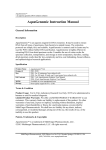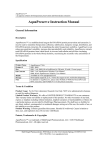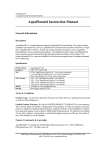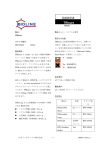Download AquaGenomic User Manual
Transcript
AquaGenomic - an aqueous genomic DNA isolation solution AquaGenomic Instruction Manual General Information Description AquaGenomic is a multifunctional aqueous solution for genomic DNA isolation and purification. This single solution functions to lyse cells, extract the DNA, and precipitate cell debris. It can be used to isolate genomic DNA from bacteria to animal tissues. The protocols are simple, fast, and scalable. Approximately 5-10 µg DNA can be isolated from 1-2 million cultured cells, 1 ml of bacterial cultures, 5-10 mg of animal tissues, or 10-20 mg of plant tissues. A260/A280 of the isolated DNA is ~1.6-1.8. Specification Product Name Product # Size Kit Contents MSDS Storage AquaGenomic Kit 2001, 2030 2001: For 10 minipreps from cultured cells 2030: For 300 mini, 30 midi, and 3 maxi preps from cultured cells 2001: 1 ml AquaGenomic Solution, Instruction Sheet 2030: 30 ml AquaGenomic Solution, Instruction Manual Available at www.aquaplasmid.com Store tightly capped at RT (~22°C). Vortex to mix well before using. Terms & Condition Product Usage: For In Vitro Laboratory Research Use Only. NOT to be administered to humans or used for medical diagnosis. Limited Product Warranty: We offer a LIMITED PRODUCT WARRANTY to our customers. This warranty limits our liability to replacement of this product. No other warranties of any kind, express or implied, including without limitation, implied warranties of merchantability or fitness for a particular purpose, are provided by MultiTarget Pharmaceuticals. We shall have no liability for any direct, indirect, consequential, or incidental damages arising out of the use, the results of use, or the inability to use this product. Patents, Trademarks & Copyrights AquaGenomic is a trademark of MultiTarget Pharmaceuticals, LLC. This technology is patent pending. 2009 Multitarget Pharmaceuticals, LLC. All rights reserved. MultiTarget Pharmaceuticals, 2150 West Dauntless Ave., Suite 101, Salt Lake City, Utah 84116 Phone: 1-888-662-6586; Fax: 1-801-303-1863; www.aquaplasmid.com AquaGenomic - an aqueous genomic DNA isolation solution AquaGenomic Cell Protocol This protocol can be used to prepare 5-10 µg of genomic DNA from 1-2 million cultured cells. For other preparation scales, use 100 µl AquaGenomic Solution for each million nucleated cells. (IMPORTANT: The micelles in AquaGenomic solution may fuse and settle down during storage, so vortex vigorously to mix well before dispensing.) 1. Harvest the Cells Pellet ~0.5-2 million cultured cells in a 1.5-ml microfuge tube by centrifugation at 2,000xg for 2 minutes. Aspirate or decant to discard the supernatant and leave behind the cell pellet. 2. Extract the DNA Add 100 µl of AquaGenomic Solution to the cell pellet. Suspend and lyse the cells by vortex vigorously for 30-60 seconds. Incubate at room temperature (preferable at 60° C for better yield) for 4 minutes. 3. Pellet the Debris (Optional: Add 5 µl 100% isopropanol to the sample and vortex to reduce foaming and allow the debris pellet become tighter following centrifugation.) Vortex vigorously for 30-60 seconds and centrifuge the sample at 10,000-20,000xg for 2 minutes to pellet the debris. 4. Pellet the DNA Transfer the supernatant (~90 µl) to a fresh 0.5-ml microfuge tube. Add 1 volume of 100% isopropanol and mix the contents by vortexing for 30 seconds. Centrifuge at 10,000-20,000xg for 4 minutes to pellet the DNA. Flip to discard the supernatant. Fill the microfuge tube with 70% ethanol by shooting the ethanol solution at the cap of the tube from a squeeze bottle, and then flip to discard the ethanol. Repeat the 70% ethanol rinse 2 times. Flip the tube and blot it several times on a paper towel to remove residual ethanol. Air-dry the DNA pellet. Add 50 µl of TE buffer or deionized water, pipette up-and-down and vortex vigorously to suspend the DNA. Centrifuge again for 2 minutes to pellet any insoluble and transfer the clear DNA solution to a new tube. Store the DNA solution at 4° or at –20° C for long-term storage. MultiTarget Pharmaceuticals, 2150 West Dauntless Ave., Suite 101, Salt Lake City, Utah 84116 Phone: 1-888-662-6586; Fax: 1-801-303-1863; www.aquaplasmid.com AquaGenomic - an aqueous genomic DNA isolation solution AquaGenomic Tissue Protocol DNA may be extracted from tissues by homogenizing or by Proteinase K digestion in AquaGenomic solution. About 10-20 µg of genomic DNA can be isolated from 10 mg of tissues. (IMPORTANT: The micelles in AquaGenomic solution may fuse and settle down during storage, so vortex vigorously to mix well before dispensing.) 1. Harvest the Cells Cut out a ~2 mm cube (~10 mg) of frozen or fresh tissue. 2. Extract the DNA By homogenization: Place the tissue in a pestle-and-tube homogenizer and homogenize in 100 µl of AquaGenomic solution at room temperature. After homogenization, add 1/10 volume (~10 µl) of 100% isopropanol to the sample to reduce forming. Briefly vortex and immediately transfer the sample into a 1.5-ml microfuge tube. Incubate at room temperature (preferable at 60° C for better yield) for 4 minutes. By Proteinase K digestion: Place the tissue in a microfuge tube preloaded with 100 µl of AquaGenomic solution containing 10 µg of Proteinase K. Incubate at 60-65 °C for 90 minutes and then at 95 °C for 10 minutes to inactivate the Proteinase K. The tissue is readily disintegrated by vortexing vigorously or pipetting. 3. Pellet the debris Vortex the sample vigorously for 30-60 seconds and centrifuge at 10,000-20,000xg for 4 minutes to pellet the debris. . 4. Pellet the DNA Transfer the clear supernatant (~80 µl) to a fresh 0.5-ml microfuge tube. Add 1 volume of 100% isopropanol and mix the contents by vortexing for 30 seconds. Centrifuge at 10,000-20,000xg for 4 minutes to pellet the DNA. Flip to discard the supernatant. Fill the microfuge tube with 70% ethanol by shooting the ethanol solution at the cap of the tube from a squeeze bottle, and then flip to discard the ethanol. Repeat the 70% ethanol rinse 2 times. Flip the tube and blot it several times on a paper towel to remove residual ethanol. Air-dry the DNA pellet. Add 50 µl of TE buffer or deionized water, pipette up-and-down and vortex vigorously to suspend the DNA. Centrifuge again for 2 minutes to pellet any insoluble and transfer the clear DNA solution to a new tube. Store the DNA solution at 4° or at –20° C for long-term storage. MultiTarget Pharmaceuticals, 2150 West Dauntless Ave., Suite 101, Salt Lake City, Utah 84116 Phone: 1-888-662-6586; Fax: 1-801-303-1863; www.aquaplasmid.com AquaGenomic - an aqueous genomic DNA isolation solution AquaGenomic Tail Protocol Unlike other tissues, mouse tail is fibrous, therefore, Proteinase K (not supplied) is added to AquaGenomic solution to assist the disintegration of the tissue. This protocol uses 100 µl of AquaGenomic solution to prepare 15-20 µg of DNA from ~10 mg (~2 mm) tail snip. (IMPORTANT: The micelles in AquaGenomic solution may fuse and settle down during storage, so vortex vigorously to mix well before dispensing.) 1. Harvest the Tissue Cut off approximately 2 mm long fresh or frozen mouse tail. Place the tissue into a microfuge tube preloaded with 100 µl of AquaGenomic solution containing 10 µg of Proteinase K (e.g., add 2 µl of 5 mg/ml Proteinase K stock solution to 100 µl of AquaGenomic solution just before the extraction). 2. Extract the DNA Incubate at 65 °C for 90 minutes and then at 95 °C for 10 minutes to inactivate the Proteinase K. The tissue is readily disintegrated by vortexing vigorously or pipetting. 3. Pellet the Debris Centrifuge at 12,000-20,000xg for 4 minutes to pellet the debris. 4. Pellet the DNA Transfer the supernatant (~80 µl) to a fresh microfuge tube. Add 1 volume of 100% isopropanol and mix the contents by vortexing for 30 seconds. Centrifuge at 10,00020,000xg for 4 minutes to pellet the DNA. Flip to discard the supernatant. Fill the microfuge tube with 70% ethanol by shooting the ethanol solution at the cap of the tube from a squeeze bottle, and then flip to discard the ethanol. Repeat the 70% ethanol rinse 2 times. Flip the tube and blot it several times on a paper towel to remove residual ethanol. Air-dry the DNA pellet. Add 50 µl of TE buffer or deionized water, pipette up-and-down and vortex vigorously to suspend the DNA. Centrifuge again for 2 minutes to pellet any insoluble and transfer the clear DNA solution to a new tube. Store the DNA solution at 4° or at –20° C for long-term storage. MultiTarget Pharmaceuticals, 2150 West Dauntless Ave., Suite 101, Salt Lake City, Utah 84116 Phone: 1-888-662-6586; Fax: 1-801-303-1863; www.aquaplasmid.com AquaGenomic - an aqueous genomic DNA isolation solution AquaGenomic Plant Protocol This protocol may be used to isolate ~10-20 µg of genomic DNA from 20 mg of plant tissues, using 200 µl AquaGenomic Solution. (IMPORTANT: The micelles in AquaGenomic solution may fuse and settle down during storage, so vortex vigorously to mix well before dispensing.) 1. Harvest the Cells Weigh out ~20 mg of fresh or frozen plant tissue. Cut the tissue into small pieces. Place them in 200 µl of AquaGenomic Solution in a pestle-and-tube homogenizer. 2. Extract the DNA Homogenize the tissue at room temperature. After homogenization, add 1/10 volume (~30 µl) of 100% isopropanol to the sample to reduce forming. Briefly vortex and immediately pour the sample into a 1.5-ml microfuge tube. 3. Pellet the debris Centrifuge at 10,000-20,000xg for 4 minutes to pellet the debris. . 4. Pellet the DNA Transfer the clear supernatant (~100 µl) to a fresh 1.5-ml microfuge tube. Add 1 volume of 100% isopropanol and mix the contents by vortexing for 30 seconds. Centrifuge at 10,000-20,000xg for 4 minutes to pellet the DNA. Flip to discard the supernatant. Fill the microfuge tube with 70% ethanol by shooting the ethanol solution at the cap of the tube from a squeeze bottle, and then flip to discard the ethanol. Repeat the 70% ethanol rinse 2 times. Flip the tube and blot it several times on a paper towel to remove residual ethanol. Air-dry the DNA pellet. Add 50 µl of TE buffer or deionized water, pipette up-and-down and vortex vigorously to suspend the DNA. Centrifuge again for 2 minutes to pellet any insoluble and transfer the clear DNA solution to a new tube. Store the DNA solution at 4° or at –20° C for long-term storage. MultiTarget Pharmaceuticals, 2150 West Dauntless Ave., Suite 101, Salt Lake City, Utah 84116 Phone: 1-888-662-6586; Fax: 1-801-303-1863; www.aquaplasmid.com AquaGenomic - an aqueous genomic DNA isolation solution AquaGenomic Microbe Protocol This protocol can be used to prepare ~10-20 µg of genomic DNA from 1 ml overnight microbial culture. For other preparation scales, use 100 µl of AquaGenomic Solution for each milliliter of overnight culture. (IMPORTANT: The micelles in AquaGenomic solution may fuse and settle down during storage, so vortex vigorously to mix well before dispensing.) 1. Harvest the Cells Centrifuge 1 ml overnight bacterial culture at 10,000-20,000xg for 30 seconds to pellet the cells. Aspirate to discard the medium and leave behind the cell pellet. 2. Extract the DNA For Gram-negative bacteria: Add 100 µl of AquaGenomic Solution to the cell pellet. Suspend the cells by vortexing vigorously for 30 seconds. Incubate the sample at 65° C for 15 minutes to lyse the cells (For some strains, cell lysis and DNA yield may be enhanced by incubating at 90° C for 30 minutes). For Gram-positive bacteria or yeast: Treat the bacterial or yeast cells with lysozyme or lyticase (not supplied) according the enzyme manufactures’ instruction. Add ~50 µl of 0.5-1 mm glass beads and 100 µl of AquaGenomic Solution to the sample. Vortex briefly and incubate the sample at 65° C for 15 minutes to lyse the cells (For some strains, cell lysis and DNA yield may be enhanced by incubating at 90° C for 30 minutes). 3. Pellet the Debris Vortex the sample vigorously for 30-60 seconds and centrifuge at 10,000-20,000xg for 4 minutes to pellet the debris. 4. Pellet the DNA Transfer the clear supernatant (~90 µl) to a fresh 0.5-ml microfuge tube. Add 1 volume of 100% isopropanol and mix the contents by vortexing for 30 seconds. Centrifuge at 10,000-20,000xg for 4 minutes to pellet the DNA. Flip to discard the supernatant. Fill the microfuge tube with 70% ethanol by shooting the ethanol solution at the cap of the tube from a squeeze bottle, and then flip to discard the ethanol. Repeat the 70% ethanol rinse 2 times. Flip the tube and blot it several times on a paper towel to remove residual ethanol. Air-dry the DNA pellet. Add 50 µl of TE buffer or deionized water, pipette up-and-down and vortex vigorously to suspend the DNA. Centrifuge again for 2 minutes to pellet any insoluble and transfer the clear DNA solution to a new tube. Store the DNA solution at 4° or at –20° C for long-term storage. MultiTarget Pharmaceuticals, 2150 West Dauntless Ave., Suite 101, Salt Lake City, Utah 84116 Phone: 1-888-662-6586; Fax: 1-801-303-1863; www.aquaplasmid.com AquaGenomic - an aqueous genomic DNA isolation solution AquaGenomic Stool and Soil Protocol This protocol uses 150 µl of AquaGenomic Solution to prepare 5-10 µg of DNA from 15 mg of feces. Isolation of pure DNA from feces or soil is difficult due to the presence of large amount of enzyme inhibitors in these samples. The protocol uses an AquaPrecipi Solution (Product # 3015, not included to remove these PCR inhibitors. (IMPORTANT: The micelles in AquaGenomic solution may fuse and settle down during storage, so vortex vigorously to mix well before dispensing.) 1. Harvest the Cells Weigh out 15 mg of wet feces (~10 mg of dry fecal pellet) or 30 mg of soil in a 1.5-ml microfuge tube. 2. Extract the DNA Add 150 µl of AquaGenomic Solution (If mitochondrial DNA extraction is desired, add Proteinase K to AquaGenomic to 100 µg/ml. Incubate at 60-65 °C for 90 minutes to digest the mitochondria and then at 95 °C for 10 minutes to inactivate the Proteinase K.) to the sample. For dry fecal sample, let it soak in AquaGenomic Solution until it is rehydrated. Homogenize the sample with a microfuge pestle or bead beater or just vortex vigorously for 1-2 minutes. Incubate the sample at 60-80° C for 15-30 minutes. 3. Pellet the Debris Vortex vigorously for 30-60 seconds and centrifuge at 10,000-20,000xg for 4 minutes to pellet the debris. 4. Pellet the DNA Transfer the supernatant (~100 µl) to a fresh 1.5-ml microfuge tube. Add 0.5 volume (50 µl) of AquaPrecipi Solution and 1 volume (100 µl) 95-100% of isopropanol. Vortex for 30 seconds to mix the contents and centrifuge at 10,000-20,000xg for 4 minutes to pellet the DNA. Flip to discard the supernatant as completely as possible. Add 200 µl of deionized water, pipette and vortex to fully suspend the pellet. Centrifuge at 10,00020,000xg for 4 minutes to pellet the insoluble. Transfer the supernatant to a new tube, add 3 volumes of 100% ethanol and centrifuge to pellet the DNA. Decant to discard the supernatant and fill the tube with 70% ethanol by shooting the ethanol solution at the cap of the tube from a squeeze bottle, and then flip to discard the ethanol. Repeat the 70% ethanol rinse 2 times. Air-dry the DNA pellet. Add 50 µl of TE buffer or deionized water, pipette up-and-down and vortex vigorously to suspend the DNA. Centrifuge again for 2 minutes to pellet any insoluble and transfer the clear DNA solution to a new tube. Store the DNA solution at 4° or at –20° C for long-term storage. MultiTarget Pharmaceuticals, 2150 West Dauntless Ave., Suite 101, Salt Lake City, Utah 84116 Phone: 1-888-662-6586; Fax: 1-801-303-1863; www.aquaplasmid.com AquaGenomic - an aqueous genomic DNA isolation solution Frequently Asked Questions Please read through these questions carefully. The answers provide additional helpful tips and useful information for the successful use of AquaGenomic. 1. Do I need to store the AquaGenomic kit in the refrigerator or freezer? No, AquaGenomic Solution is stable at room temperature (~22° C). However, the micelles in AquaGenomic will settle down during storage, and it is important that you vortex it vigorously for 30-60 minutes to mix the solution well before dispensing. 2. Should I keep the solutions and samples on ice while carrying out the isolation? No. Most of the isolation steps should be performed at room temperature (~22° C). For DNA isolation from animal cells, cell lysis at 60° C may increase the yield by ~25%. For DNA isolation from cells with a cell wall, such as bacterial cells, the cell lysis should be carried out at 60-90° C for 15-30 minutes. 3. Does AquaGenomic Solution contain Proteinase K? No. AquaGenomic can be used to extract DNA from cells and tissues without needing protease digestion. However, if mitochondrial DNA (mtDNA) recovery is desired, you will need to add Proteinase K to AquaGenomic solution to 100 µg/ml and incubate the sample at 60-65° C for 1 hour during cell lysis and then at 95 for 10 minutes to inactivate the Proteinase K. 4. What type of homogenizer do you recommend for using with AquaGenomic? Pestle-and-tube homogenizers produce more homogeneous samples. However, if you do not have a homogenizer handy or you are concerned about cross-contamination, you could use the Proteinase K digestion protocol (see AquaGenomic Tissue Protocol for details) to extract the DNA. 5. Does AquaGenomic Solution contain RNase A? No. AquaGenomic Solution can remove most RNA contaminant. Trace amount of RNA would not interfere with most genomic DNA applications. However, if complete RNA removal is desired, RNase A (200 µg/ml) can be added to the AquaGenomic solution prior to extraction. 6. Why do I need to purchase a separate reagent for fecal DNA isolation? Due to the presence of large amount of enzyme inhibitors in feces and soil, DNA isolation from these samples are particularly challenging. Precipitation of the DNA with MultiTarget Pharmaceuticals, 2150 West Dauntless Ave., Suite 101, Salt Lake City, Utah 84116 Phone: 1-888-662-6586; Fax: 1-801-303-1863; www.aquaplasmid.com AquaGenomic - an aqueous genomic DNA isolation solution isopropanol cannot remove some of the inhibitors and a specially formulated AquaPrecipi Solution (Product # 3015) is required for selective precipitation of the DNA to remove these enzyme inhibitors. 7. Can I use water for RBC lysis? For fresh blood: YES. Simply add 10 volumes of deionized water to the blood sample, vortex 20-30 seconds, centrifuge to pellet the cells, remove the red supernatant, and then proceed to extract DNA using AquaGenomic. For frozen blood: NO. Thawed RBC will not be lysed with water and you need to use our RBC Lysis Solution (Product # 4015), which is a modified hypotonic solution that lyses either fresh or frozen RBC. 8. I am concerned about cross-contamination using homogenizers, any tip? Yes. Between uses, you should thoroughly wash the homogenizer with soap and running water, soak it in 10% bleach for ~5 minutes, and then rinse it with running deionized water. This will prevent cross-contamination of the genomic DNA. If you still feel uneasy, you can use the 60° C extraction and bead milling method to disrupt the tissues. 9. My final DNA pellet does not dissolve well in water, what can I do? You may soak the final DNA pellet in water or TE buffer at room temperature for 1-16 hours, pipette up-and-down or vortex vigorously to fully disperse the pellet, and then centrifuge at 12000xg for 2 minutes to pellet any insoluble. 10. What genomic DNA yield can I expect using AquaGenomic? Approximately 10 µg DNA can be obtained from 1-2 million cultured cells, 300-400 µl of whole blood, 1 ml of overnight microbial culture, 5-10 mg of animal tissues, or 10-20 mg of plant tissues. DNA yield is dependent on the number of nucleated cells in the sample and may vary at different cell cycles and for different cell types. 11. How pure is the genomic DNA isolated by AquaGenomic? Typical A260/A280 of AquaGenomic purified DNA is 1.6-1.8. The isolated genomic DNA is free from most cellular contaminants and enzyme inhibitors. However, there may be some small RNA contamination, if RNase A treatment is not included. 12. What QC tests do you use to certify your products? Each lot is tested to ensure its performance and reliability in isolating genomic DNA. The isolated DNA (a) should have an A260/A280 ≥ 1.6, and (b) should be readily digested with restriction enzymes. MultiTarget Pharmaceuticals, 2150 West Dauntless Ave., Suite 101, Salt Lake City, Utah 84116 Phone: 1-888-662-6586; Fax: 1-801-303-1863; www.aquaplasmid.com













